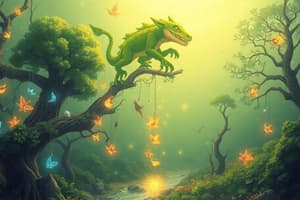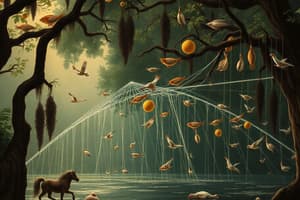Podcast
Questions and Answers
What happens to the prey of a removed species in a food web?
What happens to the prey of a removed species in a food web?
- They will decrease in population
- They will become extinct
- They will increase in population (correct)
- They will remain unaffected
What do the arrows in a food chain represent?
What do the arrows in a food chain represent?
- The direction of water flow
- The direction of nutrient flow
- The direction of energy flow (correct)
- The direction of species migration
What is the term used to describe the position of a species in a food chain?
What is the term used to describe the position of a species in a food chain?
- Food web position
- Trophic level (correct)
- Species rank
- Feeding hierarchy
What is the reason why pesticides accumulate in an individual's body?
What is the reason why pesticides accumulate in an individual's body?
What happens to energy as it is transferred between trophic levels?
What happens to energy as it is transferred between trophic levels?
What type of organism eats both plants and animals?
What type of organism eats both plants and animals?
Which process converts sugar into usable energy for organisms?
Which process converts sugar into usable energy for organisms?
What type of ecosystem is characterized by areas where water covers the soil year-round or during certain periods of the year?
What type of ecosystem is characterized by areas where water covers the soil year-round or during certain periods of the year?
What is the study of the interactions between living things, other organisms, and the environment?
What is the study of the interactions between living things, other organisms, and the environment?
Which abiotic factor is important for both terrestrial and aquatic ecosystems?
Which abiotic factor is important for both terrestrial and aquatic ecosystems?
What is the primary energy source for producers?
What is the primary energy source for producers?
Flashcards are hidden until you start studying
Study Notes
Food Webs and Chains
- A food web is a complex network of interconnected food chains, showing feeding relationships within a community.
- If a species is removed, its prey may increase while its consumers will decrease.
- If a species is added, a whole food web may be disrupted.
Food Chains
- A food chain is a simple sequence of species showing feeding relationships (who eats who).
- Arrows are used to show the direction of energy transfer between species.
Trophic Levels
- Trophic levels describe the feeding position of a species on a food chain (higher = greater predator).
- Energy is transferred between levels, with some loss due to organisms' use and release of energy.
Bioaccumulation
- Bioaccumulation is the concentration of substances (e.g., pesticides) in an individual due to its inability to excretate them.
- This occurs because substances are soluble in fats/oil, not water, and are not broken down by bodily waste.
Types of Organisms
- Omnivores: eat both plants and animals.
- Carnivores: eat only animals.
- Herbivores: eat only plants.
Cellular Respiration
- Cellular respiration is the process of converting sugar into usable energy.
- Glucose + Oxygen → Carbon Dioxide + Water.
Photosynthesis
- Photosynthesis is the process of green plants making their own food.
- Radiant Energy + Carbon Dioxide + Water → Glucose + Oxygen.
Ecosystems
- Wetland: an area where water covers or is on the surface of soil year-round or during periods.
- Wetland vegetation flourishes and adapts to wet soil, high nutrient, and water availability.
Ecology and Related Concepts
- Ecology is the study of interactions between living things, other organisms, and the environment.
- Biosphere: parts of Earth where life exists, combining the other spheres.
- Biome: a community or area with distinct plants and animals, sharing common adaptations.
Abiotic Factors
- Distinct Abiotic Factors (Aquatic):
- Salinity: concentration of salt in aquatic ecosystems, affecting water density, soil, and plant health.
- Acidity: increased acidity can disrupt species populations.
- General Abiotic Factors:
- Water availability: essential for all organisms.
- Light availability: primary energy source for producers, providing energy for all organisms.
- Nutrient availability: necessary for producers to produce ample nutrients.
- Temperature: affects species populations and ecosystem optimal conditions.
Studying That Suits You
Use AI to generate personalized quizzes and flashcards to suit your learning preferences.




